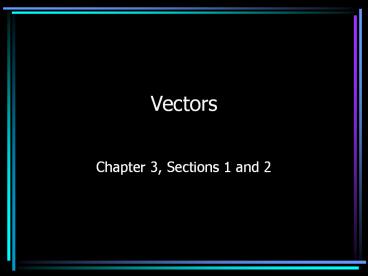Vectors - PowerPoint PPT Presentation
Title:
Vectors
Description:
Vectors Chapter 3, Sections 1 and 2 Vectors and Scalars Measured quantities can be of two types Scalar quantities: only require magnitude (and proper unit) for ... – PowerPoint PPT presentation
Number of Views:106
Avg rating:3.0/5.0
Title: Vectors
1
Vectors
- Chapter 3, Sections 1 and 2
2
Vectors and Scalars
- Measured quantities can be of two types
- Scalar quantities only require magnitude (and
proper unit) for description. Examples distance,
speed, mass, temperature, time - Vector quantities require magnitude (with unit)
and direction for complete description.
Examples displacement, velocity, acceleration,
force, momentum
3
Vector Addition
- When 2 or more vectors act on an object, the
total effect is the vector sum - Special math operations must be used with vectors
- Vector sum called the resultant
- Sum can be found using graphic methods (drawing
to scale) or mathematical methods
4
Adding Vectors Graphically
- Choose a suitable scale for the drawing
- Use a ruler to draw scaled magnitude and a
protractor for the direction - Vectors can be moved in a diagram as long as
their length and direction are not changed - Vectors can be added in any order without
changing the result
5
Adding Vectors Graphically
- Use head-to-tail method for series of sequential
vectors where each successive vector begins where
the preceding vector ended - Also works for two vectors acting simultaneously
at the same point, although drawing doesnt match
the physical situation
6
Adding Vectors Graphically
- Resultant is a vector drawn from point of origin
to tip of last vector - Magnitude of resultant can be found by measuring
and converting the measurement using the scale of
the drawing - Direction is found by measuring angle with a
protractor
7
Adding Vectors Graphically
- Graphical method gives approximate values
depending on drawing accuracy
One dimensional graphical addition of vectors
8
Subtracting Vectors
- To subtract a vector, add a negative vector, one
having same magnitude but opposite direction
b
a b
a
-b
a
a
a - b
b
9
Parallelogram Method
- Vectors are drawn from a common origin
- Complete parallelogram by drawing opposite sides
parallel to vectors - Resultant is the diagonal of the parallelogram
10
Pros and Cons for Graphical Methods
- For simultaneous vectors like forces,
parallelogram method gives a better picture of
actual situation - More difficult to draw accurately
- Better for sketches, not for measured drawings
- Head-to-tail method better for measuring
11
Parallelogram Method
- a b r
a
r
b
12
Adding Vectors Mathematically
- Exact values for vector sums using trig functions
(tan mostly) and Pythagorean theorem - Set up vectors on x-y coordinate system
- If vectors act at right angles, Pythagorean
theorem gives resultant magnitude - Direction can be found with tan-1 function
13
Resolving Vectors Into Components
- A vector acting at an angle to the coordinate
axes can be resolved into x and y components that
would add together to equal the original vector - The x-component original magnitude times the
cos of the angle measured from the x-axis - The y-component original magnitude times the
sin of the angle measured from the x-axis
14
Vector Components
vx (50 m/s)(cos 60o)
vy (50 m/s)(sin 60o)
15
Adding Non-perpendicular Vectors
- Resolve each vector into x and y components
- Add the x-components together and add the
y-components together - Use Pythagorean theorem and tan-1 function to
find magnitude and direction of resultant
16
Adding Non-perpendicular Vectors
17
Adding Non-perpendicular Vectors
Rx 11.3 12.5 23.8
Ry 4.1 21.7 25.8
_at_
18
Alternate Method for Adding Non-perpendicular
Vectors
- Consider a vector triangle with angles A, B, and
C with opposites sides labeled a, b, and c
A
c
b
C
B
a
19
Alternate Method for Adding Non-perpendicular
Vectors
- Cosine law can be used to find magnitude of
vector c if magnitudes and directions of a and b
are known - Angle between a and b can be found using simple
geometry - Sine law can be used to find direction of vector c
20
Cosine Law
- Useful if two sides (a and b) and the angle
between them (C) are known - Similar to Pythagorean Theorem with a correction
factor for lack of right angle
21
Sine Law
- Useful when one angle and its opposite side are
known along with one other side or angle































